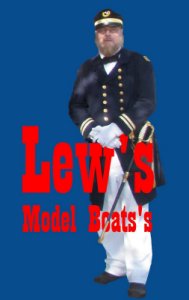
|
Welcome to - Lew's Model Boats - and more! |
go to Home Page |
| LewsModelBoats.org is not a commercial web site. Lew is a scale model builder/hobbiest (model boats and more). Views on this web site are opinions of the author and not driven by any commercial entity. Opinions are welcome - by mailing Lew (see contacts). © Copyright 2024 Lew's Model Boats. Disclosure: This Lews Model Boats do not have any financial ties to any company, political affiliation nor any other subsidy and has no gains from these and any other person(s). Lews Model Boats and this site is purely for the enjoyment of its viewers and others who enjoy this hobby. |
Updated: August
30, 2022
Fire Boat Dusseldorf
(FLB 2) - History & Operations
Forward

This site is about Lew's Model Boat's Dusseldorf FLB 2 RC Fire Boat model and the conversion/modification to replicate the real fire boat after the 1979 stretching. In order to do that all pertinent information on the real fireboat is/as necessary to help achieve that goal.
"The red ship does not show its 50 years
[59 years in 2022] of service. It has been modernized several times, also has an underwater radar and a thermal imaging camera. It's well positioned.
It will still live to see its 60th birthday, says Schroeder. However, the NRW government is planning to purchase new ships."
On this page we discuss information (what we could find) about the real fire boat perhaps not necessary to reconstruct the model, but some fun information nevertheless.
(The above right photo is that of the real Dusseldorf FLB 2.)
Original Building of the Dusseldorf (FLB 2)
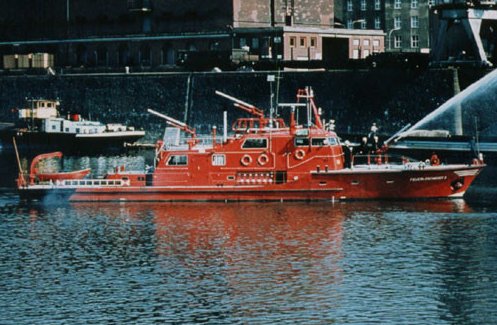 Name of the boat: Fireboat
Düsseldorf
Name of the boat: Fireboat
DüsseldorfDesignation: FLB 2 (FLB 2 is a traditional designation. The FLB 1 was in service from 1925 - 1973, the "new" FLB 2 was put into service on August 3, 1963 and retained the designation.) For firefighting, technical assistance and emergency rescue on the Rhine, priority is given to the fire-fighting boat station in the port with the "Fire-fighting boat 2" and a lifeboat (RTB 2, accommodation for a maximum of 5 people (with a crew of 2) as well as a stretcher or portable pump. )
Manufacturer: Rheinwerft Mainz-Mombach (Yard No. 169)
Year of construction 1962-1963, and commissioning: 1963
Dimensions:
Length: 29,27m
Width: 6,3m
Draft: 1,3m
Weight: ?
Engines: MAN diesel engines (2)
ENI number: 04402440 MMSI: 211524640
Call sign: DA5276
Width: 6,3m
Draft: 1,3m
Weight: ?
Engines: MAN diesel engines (2)
ENI number: 04402440 MMSI: 211524640
Call sign: DA5276
Major Re-building (1979) of the Dusseldorf FLB 2)
 The
Dusseldorf had its 58th birthday in 2021. This proved that ships have a much longer service life
than most land vehicles. Boats with a stable hull can be converted, expanded and modernized in many different ways. In 1979 the ship grew by exactly 4.59 meters.
The
Dusseldorf had its 58th birthday in 2021. This proved that ships have a much longer service life
than most land vehicles. Boats with a stable hull can be converted, expanded and modernized in many different ways. In 1979 the ship grew by exactly 4.59 meters.This extension also increased the displacement (weight) of the boat so that the draft reduced to 1.28 after the extension. The hull lengthening from 1979 was carried out in the Ruhrort shipyard . Also, new devices were newly or modernized.
1980 Status (photo)
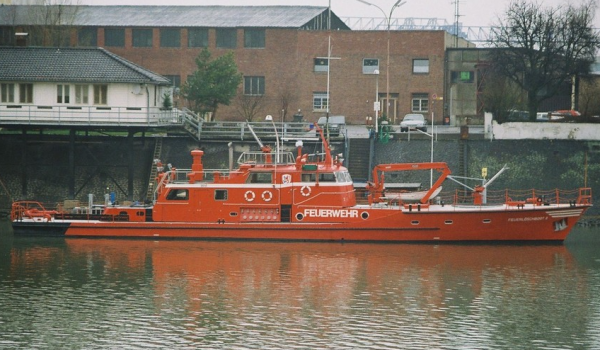 About 1980 the
Dusseldorf is shown in the photo, right. I can't tell you what changed between 1980 and the current version as the photos are not high enough in
quality to examine properly. Obviious is the new paint scheme where the whtie band along the structure is now much wider encompassing the windows. There
appears to be more electronics (antennas, etc.) on the top of the structure in the newer photos which would make sense. Also apparent is the fire nozzels
(monitors) look like the old type, manually operated which were later replaced with remote control nozzels.
About 1980 the
Dusseldorf is shown in the photo, right. I can't tell you what changed between 1980 and the current version as the photos are not high enough in
quality to examine properly. Obviious is the new paint scheme where the whtie band along the structure is now much wider encompassing the windows. There
appears to be more electronics (antennas, etc.) on the top of the structure in the newer photos which would make sense. Also apparent is the fire nozzels
(monitors) look like the old type, manually operated which were later replaced with remote control nozzels.Click on photo for a link to the source. >>>
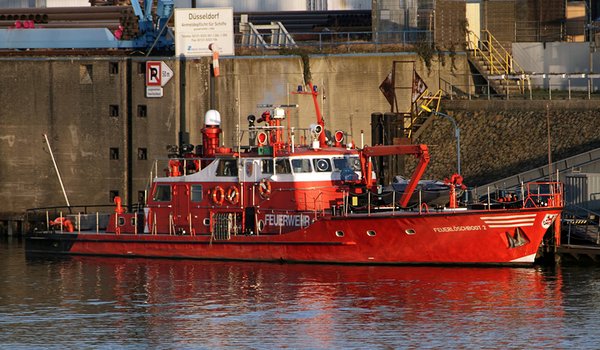 1991 Upgrade
(new engines)
1991 Upgrade
(new engines)The original diesel engines were then replaced by modern MTU engines.
Dimensions:
Length: 33,89m
Width: 6,3m
Draft: 1,28m
Weight: 98 tons
Engines: MTU 1067 HP V8 engines, each with a continuous output of 715 kW and a maximum short-term output of 785 kW each (2)
Speed: 45 km/h down the valley and around 35 km/h up the mountain.
Other:
A bow thruster of 530 millimeters and 55 kW power makes maneuvering easier.
There is also an MAN engine with an output of 176 kW as an auxiliary diesel on board. It supplies the entire ship with all facilities with electricity (150 kVA at 400 volts).
Every two years the FLB-2 comes into the dry dock for technical testing and renovation.
The entire fire-fighting equipment is state-of-the-art.
Stern trim plate is not for more speed, but actually a smaller stern wave because of the limit of a 1.8 meter wave height on this area of the Rine River so as to limit the actual maximum speed on this busy waterway.
Width: 6,3m
Draft: 1,28m
Weight: 98 tons
Engines: MTU 1067 HP V8 engines, each with a continuous output of 715 kW and a maximum short-term output of 785 kW each (2)
Speed: 45 km/h down the valley and around 35 km/h up the mountain.
Other:
A bow thruster of 530 millimeters and 55 kW power makes maneuvering easier.
There is also an MAN engine with an output of 176 kW as an auxiliary diesel on board. It supplies the entire ship with all facilities with electricity (150 kVA at 400 volts).
Every two years the FLB-2 comes into the dry dock for technical testing and renovation.
The entire fire-fighting equipment is state-of-the-art.
Stern trim plate is not for more speed, but actually a smaller stern wave because of the limit of a 1.8 meter wave height on this area of the Rine River so as to limit the actual maximum speed on this busy waterway.
Other Boats Of the Same Design
Two other fire boats of the same design as the Dusseldorf were built. These were the FLB Köln (Florian Cologne) and FLB Duisburg.
The information follows:
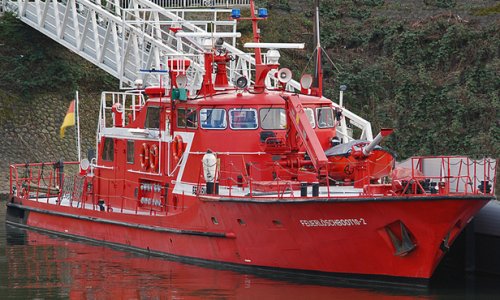 Köln
(Ex-Name: Hydra) Call sign: FDC2516
Köln
(Ex-Name: Hydra) Call sign: FDC2516
Location: Cologne
Builder: Mainz-Mombach - Rhine shipyard
Year Built: 1962
Notes: The boat is regularly modernized.
In 1981 it was extended by more than 5m.
In 1998 a new fixed pipe system.
In the 90s new engines, two MAN ship diesels with 1000 HP replaced the old
Hentschel engines.
1995-1996, loading crane & dory.
Operating area: Rhine River from Oberwinter 639km to Duisburg-Orsoy 795km.
.jpg) Duisburg
Duisburg
Location (formerly): Duisberg
Builder: Mainz-Mombach - Rhine shipyard
Year Built: 1962
Notes:
Final disposition: 2012 in Haarlem City, Netherlands awaiting scrapping.
 Köln
(Ex-Name: Hydra) Call sign: FDC2516
Köln
(Ex-Name: Hydra) Call sign: FDC2516Location: Cologne
Builder: Mainz-Mombach - Rhine shipyard
Year Built: 1962
Notes: The boat is regularly modernized.
In 1981 it was extended by more than 5m.
In 1998 a new fixed pipe system.
In the 90s new engines, two MAN ship diesels with 1000 HP replaced the old
Hentschel engines.
1995-1996, loading crane & dory.
Operating area: Rhine River from Oberwinter 639km to Duisburg-Orsoy 795km.
.jpg) Duisburg
DuisburgLocation (formerly): Duisberg
Builder: Mainz-Mombach - Rhine shipyard
Year Built: 1962
Notes:
Final disposition: 2012 in Haarlem City, Netherlands awaiting scrapping.
Crew for the Dusseldorf
The crew currently consists of 24 men, who are divided between the two watch stations, plus a station manager on day duty.
In addition to the fire-fighting technical training and the paramedic/paramedic, the fire boat crew also has the following qualifications:
Five men are constantly on duty and are part of the boat crew. In addition to the fireboat, they also occupy a lifeboat, which is used to quickly rescue people.
• Sport boat driving license inland
• Radio communication certificate Rhine
• Rhine patent for the entire route in North Rhine-Westphalia
• Radar patent for the entire route in North Rhine-Westphalia
• Further training radar (Water Police School Hamburg)
• Additional training in ship firefighting
• Additional training in engine maintenance
• Radio communication certificate Rhine
• Rhine patent for the entire route in North Rhine-Westphalia
• Radar patent for the entire route in North Rhine-Westphalia
• Further training radar (Water Police School Hamburg)
• Additional training in ship firefighting
• Additional training in engine maintenance
Five men are constantly on duty and are part of the boat crew. In addition to the fireboat, they also occupy a lifeboat, which is used to quickly rescue people.
Dusseldorf Equipment
 In addition to two fire monitors with a total of 10,000 liters per minute and a supply of 4,500 liters of alcohol-resistant AFFF foam agent, its strength lies in the
possibilities for technical assistance.
In addition to two fire monitors with a total of 10,000 liters per minute and a supply of 4,500 liters of alcohol-resistant AFFF foam agent, its strength lies in the
possibilities for technical assistance.The crane mounted on the bow with a length of approx. 8 m is used not only for lifting the dinghy, but also for other purposes. Pumps, two 3,500 l/min; two 2,300 l/min; two 1,000 l/min; one x 400 l/min) with a total bilge capacity of 14,000 l/min. On damaged ships, a total of 30,800 l/min can be pumped out with submersible pumps and built-in fire-fighting centrifugal pumps (two FP 8,400 l/min).
Extensive PPE is available for the crew: in addition to the obligatory clothing and life jackets suitable for firefighting, special cold protection suits, PA and CSA (with securing option on the back).
Gas measuring and radiation measuring devices are available as well as night vision devices, thermal imaging cameras, emergency kits and defibrillators. A new radar device that also processes GPS data is currently being retrofitted.
Location and Operations of the Dusseldorf
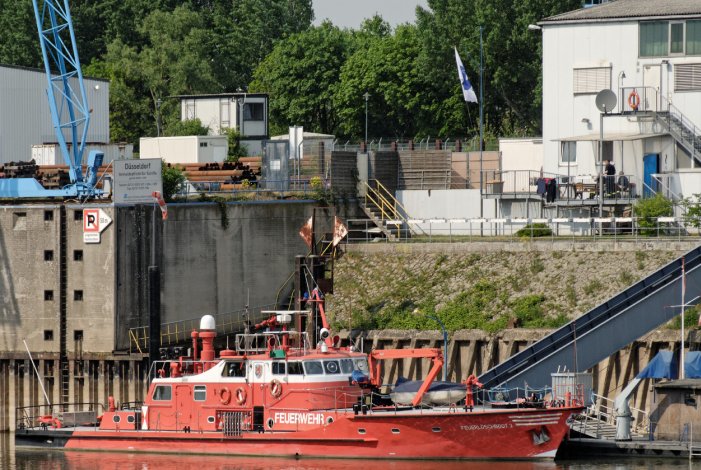 The Fire Station
The Fire StationThe original fireboat station was located at the top of Speditionstrasse from 1970 to 2003. At that time, all construction measures were carried out by the fireboat colleagues themselves. The station was heated by an oil heater, which was located in the kitchen.
During the Advent flood in December 1996, the building was about 20 centimeters under water. After that, all the floors, including the insulation, had to be replaced. Due to planned construction projects at the top of Speditionstraße (today's Hyatt), a new location had to be found for the fireboat.
One of the selection criteria for this new fire station (photo, right) was the shortest possible travel time to the port exit. A freight forwarding building on the west bank (Bremer Straße) met the requirements. It was rebuilt and expanded in its base area within the adjoining warehouse. The scheduled relocation of the station took place on February 13, 2003. Berth: 40221 Düsseldorf, Bremer Str. 68 (on the right bank of the Rhine, near the port exit) approx.
Note "FLB" on map (right) is the location of the fire station for the boats.
Five separate functions are available for both boats around the clock (the special qualification requirements, especially fireboat patent and radar patent, require this). For most situations, both boats move out at the same time.
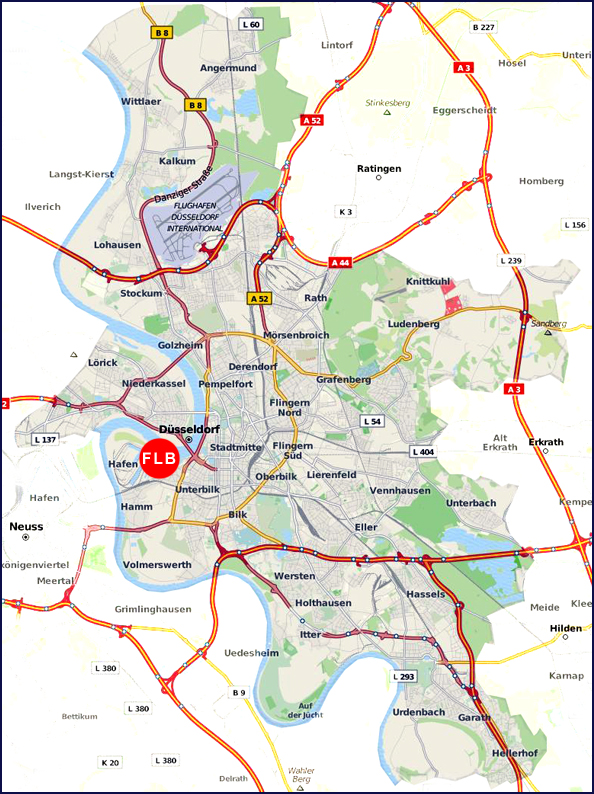 The manovrable and fast multi-purpose or rescue boat (max. 60 km/h) offers an important time advantage, since the large fire-fighting boat (max. approx. 45 km/h) can reach the
southern city limits (upstream, "to mountain ") takes about 90 minutes.ern fire-fighting group. They are alerted in parallel to the BF; if necessary also all units together via lifeboats. Depending on
the location of the scene, they will also be alerted.
The manovrable and fast multi-purpose or rescue boat (max. 60 km/h) offers an important time advantage, since the large fire-fighting boat (max. approx. 45 km/h) can reach the
southern city limits (upstream, "to mountain ") takes about 90 minutes.ern fire-fighting group. They are alerted in parallel to the BF; if necessary also all units together via lifeboats. Depending on
the location of the scene, they will also be alerted.Area of application: Rhine and Düsseldorf harbour.
The alarm is sent via the Düsseldorf control center.
The responsibility for the rescue service, firefighting and technical assistance on the Rhine extends primarily to the city area with 46 river kilometers. The area of application does not end at the city limits, but extends from the state border to Rhineland-Palatinate in the south to the Dutch border in the north, over a total distance of 226 kilometers.
End